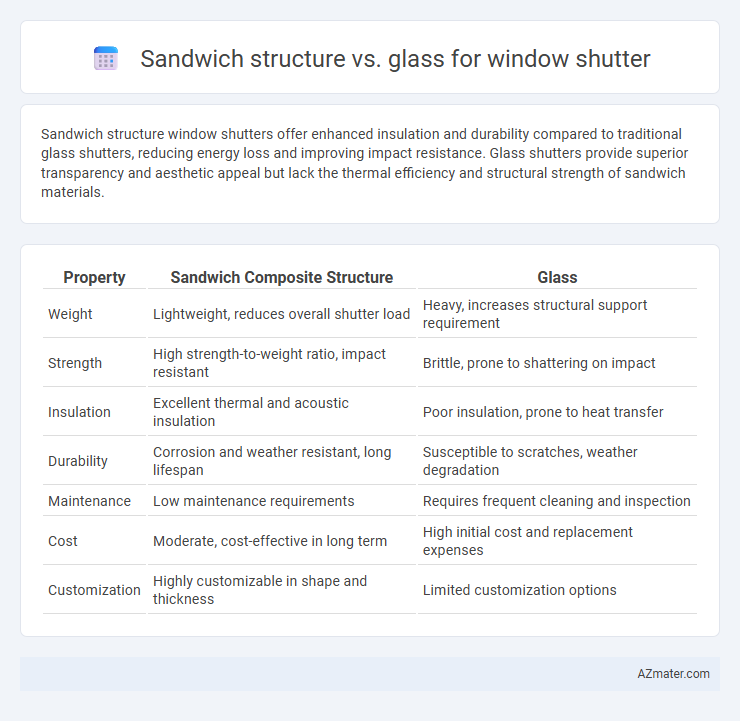Sandwich structure window shutters offer enhanced insulation and durability compared to traditional glass shutters, reducing energy loss and improving impact resistance. Glass shutters provide superior transparency and aesthetic appeal but lack the thermal efficiency and structural strength of sandwich materials.
Table of Comparison
| Property | Sandwich Composite Structure | Glass |
|---|---|---|
| Weight | Lightweight, reduces overall shutter load | Heavy, increases structural support requirement |
| Strength | High strength-to-weight ratio, impact resistant | Brittle, prone to shattering on impact |
| Insulation | Excellent thermal and acoustic insulation | Poor insulation, prone to heat transfer |
| Durability | Corrosion and weather resistant, long lifespan | Susceptible to scratches, weather degradation |
| Maintenance | Low maintenance requirements | Requires frequent cleaning and inspection |
| Cost | Moderate, cost-effective in long term | High initial cost and replacement expenses |
| Customization | Highly customizable in shape and thickness | Limited customization options |
Introduction to Window Shutter Materials
Sandwich structures in window shutters combine multiple layers of materials like metal, foam, and composites to offer enhanced insulation, durability, and strength compared to traditional glass. Glass window shutters primarily provide transparency and natural light but lack the thermal insulation and impact resistance found in sandwich structures. Choosing between sandwich structure and glass materials depends on factors such as energy efficiency, security needs, and design preferences.
Overview of Sandwich Structure Technology
Sandwich structure technology for window shutters incorporates a core material, typically foam or honeycomb, placed between two outer layers, often aluminum or composite panels, enhancing insulation and strength. This design significantly improves thermal performance and impact resistance compared to traditional glass shutters. Lightweight yet durable, sandwich panels provide better energy efficiency and noise reduction while maintaining structural integrity.
Traditional Glass in Window Shutters
Traditional glass in window shutters offers clear visibility and natural light transmission, but it lacks the thermal insulation and impact resistance provided by sandwich structures. Sandwich structures, composed of layered materials such as polycarbonate or insulated panels, enhance energy efficiency and durability while reducing noise infiltration. Choosing between traditional glass and sandwich structures depends on priorities like aesthetics, insulation, and security in window shutter applications.
Comparative Strength and Durability
Sandwich structure window shutters typically consist of a core material like foam or honeycomb sandwiched between two outer layers, offering enhanced strength-to-weight ratio and superior impact resistance compared to traditional glass shutters. Glass shutters provide aesthetic clarity and natural light transmission but are more prone to breakage and require regular maintenance to prevent cracks and chips. Overall, sandwich structures excel in durability and structural integrity, making them ideal for environments demanding high resilience and longevity.
Thermal Insulation Properties
Sandwich structure window shutters feature multiple layers of insulating materials such as polyurethane foam, significantly enhancing thermal insulation compared to traditional glass shutters. Glass shutters, even when double-glazed, typically exhibit higher thermal conductivity, allowing more heat transfer and reducing energy efficiency. The sandwich structure's ability to minimize heat loss and gain makes it a superior choice for maintaining indoor temperature stability and lowering heating or cooling costs.
Soundproofing Capabilities
Sandwich structure window shutters feature multiple layers combining materials like wood, foam, and metal that enhance soundproofing capabilities by dampening and blocking airborne noise more effectively than single-pane glass shutters. Glass window shutters, typically made from tempered or laminated glass, offer limited sound insulation due to their rigid and less absorptive nature. Sandwich structures reduce decibel levels by trapping sound waves within their composite layers, creating a superior barrier against external noise for quieter indoor environments.
Safety and Impact Resistance
Sandwich structures provide enhanced safety and impact resistance for window shutters by combining multiple layers of materials such as metal and foam, creating a robust barrier that absorbs and dissipates impact forces effectively. Glass shutters, while offering transparency and aesthetic appeal, are more prone to shattering upon impact, posing greater safety risks without additional protective treatments like laminates or tempered glass. The inherent design of sandwich structures minimizes breakage and enhances durability, making them a safer choice for high-impact environments.
Energy Efficiency Considerations
Sandwich structure window shutters incorporate layers of insulation materials that significantly reduce thermal transfer, enhancing energy efficiency by maintaining indoor temperatures and lowering heating and cooling costs. Glass shutters, typically single or double glazed, provide moderate insulation but often fall short in preventing heat loss or gain compared to advanced sandwich panels. Opting for sandwich structures improves energy conservation by minimizing thermal bridging and increasing overall R-values, making them a superior choice for sustainable window solutions.
Maintenance and Longevity
Sandwich structure window shutters offer superior durability and require less maintenance compared to traditional glass shutters due to their composite layers that resist warping and impact. Glass shutters, while aesthetically pleasing, are prone to cracking and require regular cleaning and careful handling to maintain clarity and functionality. The longevity of sandwich structure shutters often surpasses glass shutters, as their engineered materials withstand environmental stress and reduce the need for frequent repairs or replacements.
Cost and Installation Factors
Sandwich structure window shutters generally offer lower installation costs due to their lightweight design and ease of handling compared to traditional glass panels. While glass shutters provide superior transparency and aesthetic appeal, their higher material and labor costs make them less cost-effective for budget-conscious projects. The sandwich structure also reduces the need for heavy-duty frames and hardware, streamlining installation and minimizing overall expenditure.

Infographic: Sandwich structure vs Glass for Window shutter
 azmater.com
azmater.com